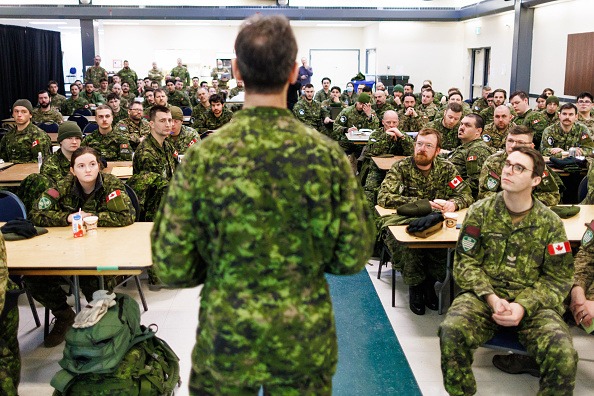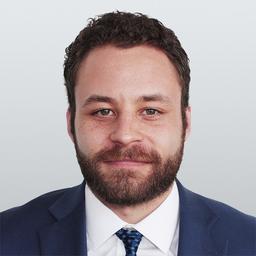
Lt. Col. Darren Turner gives a briefing to soldiers from the 5th Canadian Division inside the Midnight Sun Complex, a makeshift command post used by the military during Operation Nanook, the Canadian Armed Forces’ annual Arctic training and sovereignty operation, in Inuvik, Northwest Territories, Canada, March 2, 2025. (Photo by Cole BURSTON / AFP)
The Canadian Armed Forces (CAF) is struggling to recruit enough members to meet its operational requirements and does not have enough adequate housing for its members, according to two new reports by Canada’s Auditor General Karen Hogan.
Hogan’s Oct. 21 report on recruiting said that while thousands applied annually, only 1 in 13 applicants was successfully recruited by the CAF over the last three years.
“The armed forces also did not have sufficient basic training capacity to meet the demand if the recruitment targets had been met,” Auditor General Karen Hogan told the Public Accounts Committee on Oct. 21 while presenting her findings.
The CAF had planned to recruit just over 19,700 new members during the audit period between April 1, 2022, and March 31, 2025, but only recruited around 15,000 of the nearly 192,000 people who applied.
Although the number of recruits for the 2022–23 and 2023–24 fiscal years fell short of the overall recruitment targets, the military surpassed its recruitment targets in 2024–25 by 210.
The report found that while the military aimed to have a recruitment time of between 100 and 150 days, it often took twice as long.
While the CAF has an authorized staffing level of 71,500 regular force members and 30,000 primary reserve members, it had just 65,154 regular force members and 23,561 primary reserve members as of April 30, 2025.
The audit found that around 192,000 people submitted an online application to join the CAF between April 2022 and March 2025, but 103,700, or 54 percent, voluntarily withdrew during recruitment or did not respond to CAF outreach efforts.
The audit found that the CAF faces ongoing challenges in maintaining its workforce across various occupations, specifically in expanding training capacity and attracting enough highly skilled recruits in roles such as pilot, combat engineer, and technicians in a variety of technical areas. Its recruiting targets were also not sufficient to maintain the optimal workforce, and did not always account for those leaving the armed forces.
The report also said that while the CAF was able to train all of its recruits during the scope of the audit, it would not have had the capacity to do so if recruitment targets had been met. The report found there was a shortage of instructors, as well as not enough equipment to carry out training operations, which it said could “put future training at risk.”
However, the report acknowledged that the CAF made changes during the audit period to increase the number of recruits, such as by removing the CAF aptitude test, implementing application forms that capture past work experience, adjusting medical requirements, and allowing members to begin occupational training while security clearances are being assessed.
The auditor general recommended that the CAF analyze the most common reasons why applicants withdraw from the recruitment process; attempt to understand why some occupations remain understaffed; ensure sufficient investments in instructors, training infrastructure, and equipment to increase recruits; and modernize the information technology systems that support recruitment activities.
The report said the CAF agreed with the recommendations.
In August, the federal government announced it would increase salaries for CAF members, allocating $9 billion to provide an 8 percent pay raise for colonels and above, a 13 percent raise for lieutenant-colonels and below, and a 20 percent increase in starting pay for privates.
Hogan told the committee she believed that increased salaries would improve recruitment and retention in the CAF, but said the military should begin by understanding “why more than half of the people who apply sort of abandon the recruitment process.”
Hogan also said it was too early to determine what impact the changes the CAF made to the application process would have on recruitment.
Housing Issues
A separate report on housing released by Hogan’s office the same day found that the Department of National Defence (DND) needs an additional 5,200 to 7,200 residential housing units for its members, and its plan to build new housing still leaves a gap of at least 3,800 units.
The report also found that the department does not have reliable data on its housing and that some living quarters are in poor condition and lack clean water and proper sanitation.
The report said the Canadian Forces Housing Agency (CFHA) has not provided enough housing units to meet the CAF’s needs, and 3,706 applicants were on waiting lists in the spring of 2025.
In addition, the report said the CFHA also failed to complete 26 percent of its inspections of residential housing units, which are required to take place every three years. The agency said 1,445 units were in “below average” condition for the 2024 fiscal year, under its target of no more than 1,635 below-average units. However, the report was based on incomplete information, since 26 percent of required inspections were not done.
The auditors examined three military bases “in depth” and found many DND quarters buildings had “significant issues.” Out of 35 quarters inspected by auditors, 32 needed at least one high-priority repair, such as addressing a lack of potable water, malfunctioning sanitary waste systems, or deteriorating exterior walls.
The report also said outdated information is being used by the CFHA to make decisions on retrofitting existing housing units and building new units.
The report recommends that DND clarify the role of military housing, meet inspection targets, and conduct necessary maintenance and repairs. It also says the CFHA should review how quarters are allocated to meet the needs of priority applications and ensure inspections are completed on time. DND and CFHA said they agreed with the recommendations.
In Budget 2024, the government allocated $6.9 million over five years with $1.4 billion in future years to build up to 1,400 homes and renovate 2,500 existing units on bases and wings. When Hogan was asked about the funding’s timing at the committee meeting, she said it was a “really long horizon” and it was “impossible” to gauge whether it would be enough to address the concerns raised in the report.
“But what I could tell you is a lot of [DND’s] plans and estimates are based on outdated information, and they should start by at least updating that information and then incorporating the desire to recruit more in order to see whether or not they have enough budget to deal with the housing issues,” she said.
Defence Minister David McGuinty thanked the auditor general for her report and said the defence department has “work to do” on housing for CAF members. He told reporters that the DND is working “right across the country at all 33 of our bases” to build and retrofit new housing units.
“Governments, successively, have not been making the investments we need to make in our armed forces. We’re doing that. That’s why we’ve made this largest single investment,” he said, pointing to the additional $9 billion Ottawa set aside for salary increases for the CAF.
Matthew Horwood is a reporter based in Ottawa.
